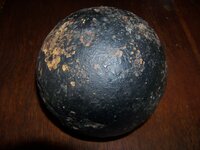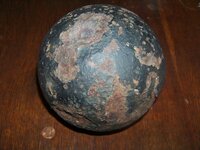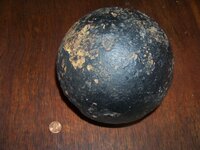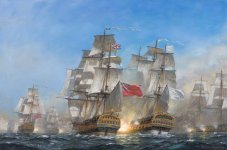mollyk927
Jr. Member
I purchased this cannon ball back in the late 80's in a small antique shop in Cape Charles, VA--not because I am a history buff, but rather as a gift for my stepfather's birthday (his last name was Cannon).
At the time, I was told it was from the Revolutionary War (and, at the time, I was more interested in it as a gift rather than a piece of history, and didn't press for details). It has come back to me as an inheritance, and I decided to research it a bit--possibly with the intent to sell. This cannon ball has taught me more history than I ever cared to learn in school, and in that regard is worth its weight in gold... the things I never knew!
It was during this research that I stumbled across Treasure.net and learned that The Cannon Ball Guy is the one who may answer my questions: is it really a cannon ball (and not a ball used for crushing ore or some such), and if so, is it really from the Revolutionary War? In trying to identify it myself, I learned that its weight and diameter are paramount to identification (and also that the bathroom scale just isn't accurate enough), so I hauled it over to the Post Office where the clerk kindly weighed it for me. It weighs exactly 31 pounds, 12 ounces. As for the diameter, I've only used a cloth tape (not wanting to go out and purchase a special tape measure that I will likely only use once in my life), and measured the circumference to 19.75", which the handy-dandy online diameter calculator says is 6.28663". These are not the exact measurements I have seen in the military ordinances, and so am left wondering.

I'll appreciate any insight or information anyone may have!
At the time, I was told it was from the Revolutionary War (and, at the time, I was more interested in it as a gift rather than a piece of history, and didn't press for details). It has come back to me as an inheritance, and I decided to research it a bit--possibly with the intent to sell. This cannon ball has taught me more history than I ever cared to learn in school, and in that regard is worth its weight in gold... the things I never knew!
It was during this research that I stumbled across Treasure.net and learned that The Cannon Ball Guy is the one who may answer my questions: is it really a cannon ball (and not a ball used for crushing ore or some such), and if so, is it really from the Revolutionary War? In trying to identify it myself, I learned that its weight and diameter are paramount to identification (and also that the bathroom scale just isn't accurate enough), so I hauled it over to the Post Office where the clerk kindly weighed it for me. It weighs exactly 31 pounds, 12 ounces. As for the diameter, I've only used a cloth tape (not wanting to go out and purchase a special tape measure that I will likely only use once in my life), and measured the circumference to 19.75", which the handy-dandy online diameter calculator says is 6.28663". These are not the exact measurements I have seen in the military ordinances, and so am left wondering.


I'll appreciate any insight or information anyone may have!
Attachments
Upvote
0




 ... and here is the information you've requested in the post and in your PM.
... and here is the information you've requested in the post and in your PM.


